|
|
|
Ramie is
one of the strongest natural fibers. It exhibits even greater
strength when wet. Ramie fiber is known especially for its
ability to hold shape, reduce wrinkling, and introduce a silky
lustre to the fabric appearance. It is not as durable as other
fibers, and so is usually used as a blend with other fibers such
as cotton or wool. It is similar to flax in absorbency, density
and microscopic appearance. However it will not dye as well as
cotton. Because of its high molecular crystallinity, ramie is
stiff and brittle and will break if folded repeatedly in the
same place; it lacks resiliency and is low in elasticity and
elongation potential.[3]
|
|
|
|
Physical
and chemical properties of ramie fiber |
|
Cellulose
(wt%) |
Lignin
(wt%) |
Hemicellulose (wt%) |
Pectin
(wt%) |
Wax (wt%) |
Microfibrillar angle (°) |
Moisture
content (wt%) |
Density
(mg/m3) |
|
68.6 - 76.2 |
0.6 - 0.7 |
13.1 - 16.7 |
1.9 |
0.3 |
7.5 |
8.0 |
1.50 |
|
Source: [4] |
|
|
|
|
Mechanical properties of untreated ramie fibers |
|
Fiber
diameter (mm) |
Fracture
load (N) |
Tensile
strength (MPa) |
Fracture
strain (%) |
|
0.034 |
0.467 |
560 |
0.025 |
|
Source: [5] |
|
|
|
|
Uses |
|
Despite its strength, ramie has had limited
acceptance for textile use. The fiber's extraction and cleaning
are expensive, chiefly because of the several steps—involving
scraping, pounding, heating, washing, or exposure to chemicals.
Some or all are needed to separate the raw fiber from the
adhesive gums or resins in which it is ensheathed. Spinning the
fiber is made difficult by its brittle quality and low
elasticity; and weaving is complicated by the hairy surface of
the yarn, resulting from lack of cohesion between the fibers.
The greater utilization of ramie depends upon the development of
improved processing methods.
Ramie is used to make such products as
industrial sewing thread, packing materials, fishing nets, and
filter cloths. It is also made into fabrics for household
furnishings (upholstery, canvas) and clothing, frequently in
blends with other textile fibers (for instance when used in
admixture with wool, shrinkage is reported to be greatly reduced
when compared with pure wool.) Shorter fibres and waste are used
in paper manufacture.
Ramie is also used as an ornamental plant in
eastern Asia.
Ramie (Boehmeria nivea), commonly known as China grass, white
ramie, green ramie and rhea, is one of the group referred to as
the bast fiber crops. It is a hardy perennial belonging to the
Urticaceae or Nettle family, which can be harvested up to 6
times a year. It produces a large number of unbranched stems
from underground rhizomes and has a crop life from 6 to 20
years. The bark contains gums and pectins causing the fibers to
be useable only after chemical treatment. |
|
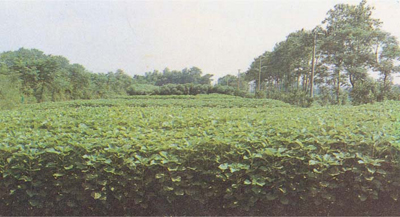 |
The
true ramie or ‘China Grass' is also known as ‘white ramie' and
is the Chinese cultivated plant. It has large heart shaped,
crenate leaves covered on the underside with white hairs that
give it a silvery appearance. Boehmeria nivea var. tenacissima,
is known as ‘green ramie' or ‘rhea'. It is believed to have
originated in the Malay Peninsula. It has smaller leaves which
are green on the underside, and is better suited to tropical
climates.
|
|
Ramie is one of the oldest textile fibers. It was used in mummy
cloths in Egypt during the period 5000 - 3000 BC, and has been
grown in China for many centuries. The main producers of ramie
today are China, Brazil, Philippines, India, South Korea and
Thailand. Only a small percentage of the ramie produced is
available on the international market. Japan, Germany, France
and the UK are the main importers, the remaining supply is used
domestically (in the country in which it is produced).
Ramie fiber is very durable, is pure white in colour and has a
silky luster. It is reported to have a tensile strength eight
times that of cotton and seven times greater than silk. However,
other reports claim that the tensile strengths of cotton, flax,
hemp and ramie are similar. These discrepancies can be partly
attributed to the effects of source of supply, method of
processing, the test conditions, temperature and humidity, on
the fiber strength.
The
stems of ramie grow to a height of 1 - 2.5 meters. The most
suitable climate for ramie is one which is warm and humid, with
an annual rainfall of at least 1000 mm. Well established plants
can tolerate drought and frost, but grow better without. As
ramie productivity is high it can rapidly deplete the soil of
nutrients.
|
|
|
|
|
Properties |
|
Advantages of Ramie as a Fabric :
|
|
●
|
|
Resistant to bacteria, mildew, alkalis, rotting, light,
insect attack. |
|
●
|
|
Extremely absorbent and therefore comfortable to wear,
especially during warm weather. |
|
|
|
Has natural stain resisting ability with ease of stain/soil
removal similar to that of linen (and this is better than
cotton). |
|
●
|
|
Not harmed by mild acids. |
|
●
|
|
Dyes fairly easily. |
|
●
|
|
Good wet-fastness in laundering - though dark colors may
lose their vibrancy over repeated launderings. |
|
●
|
|
Increases in strength when wet. |
|
●
|
|
Withstands high water temperatures during laundering. |
|
●
|
|
Smooth lustrous appearance improves with washing. |
|
●
|
|
Keeps its shape and does not shrink. |
|
●
|
|
Can be bleached. |
|
|
|
|
|
Disadvantages of Ramie as a Fabric :
|
|
●
|
|
Low in elasticity. |
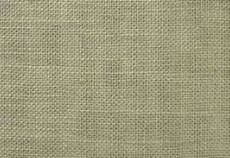
|
|
●
|
|
Low abrasion resistance. |
|
●
|
|
Wrinkles easily (but application of wrinkle-resistant
finishes or blending with synthetic fibers can reduce the
problem in woven fabrics). |
|
●
|
|
Stiff and brittle. |
|
●
|
|
The fiber is high cost which reduces its competitiveness
against other textile fibers - this high cost is due to high
labor requirement for production, harvesting and
decortication. |
|
●
|
|
There is a need to de-gum the fiber prior to processing. |
|
|
|
|
|
|
|
|
Applications |
|
● |
|
Apparel. |
|
● |
|
dresses, suits, skirts, jackets, pants, blouses, shirts,
children wear, mixed with cotton in knitted sweaters. |
|
● |
|
Home Fashion. |
|
● |
|
curtains, draperies, upholstery, bedspreads, table linens,
sheets, dish towels. |
|
● |
|
Sewing thread. |
|
● |
|
Handkerchiefs. |
|
● |
|
Parachute fabrics. |
|
● |
|
Woven fire hoses. |
|
● |
|
Narrow weaving. |
|
● |
|
Canvas. |
|
● |
|
Filter cloth. |
|
● |
|
When used in a mixture with wool, shrinkage is reported to
be greatly reduced when compared with pure wool. |
|
● |
|
Short waste fibers are used for the production of high
quality papers, such as bank notes & cigarette papers. |
|
● |
|
As ramie takes up phosphorous, it is potentially useful for
cleaning up the Everglades. This region suffers from a
nutrient overload from the sugar industry. |
| |
|
|
|
|
Ramie
as a Blend |
|

|
Ramie is most often blended (common is 55% ramie/45% cotton)
with other fibers for its unique strength and absorbency, luster
and dye-affinity. When blended with high-quality cotton it
offers increased luster, strength and color.
When mixed with
wool, ramie adds lightness and minimizes shrinkage. When blended
with rayon, it offsets the low wet strength.
|
| |
|
|
|
Care
Recommendations
for
Ramie
Fabrics |
| |
|

|
Care
procedures prescribed on the care labels of ramie products vary.
Items of 100 percent ramie should not require special care.
Generally, they may be laundered or dry-cleaned depending on
individual dyes, finishes and design applications.
High
temperatures will not harm the fiber itself, making washing in
hot water and ironing at high settings possible; however, color
retention, shrinkage control or properties of blended fibers may
dictate lower temperatures.
|
|
Recent laboratory testing done has
led to the conclusion that the best performance results when
gentler or more special handling is used in care. For example,
fabrics retained the best color and shape with the most
wrinkle-free appearance when they were dry-cleaned.
Machine washing in cold water on gentle cycle with line drying
was better than machine washing in warm water with tumble drying
on permanent press cool down cycle.
|
 |
| |
|
|
|
 |
Hand washing in cool water
with flat drying is the most strongly recommended home care
method for both knits and woven fabrics. The consumer who knows
the strengths and limitations of the fiber can receive maximum
service and enjoyment from ramie products.
When
storing ramie or ramie blends, lay them flat. Ramie fibers are
brittle and tend to break.
Avoid folding the garment or pressing
sharp creases in woven fabrics.
|
|
|
|
|
Ramie's
role in
farming
systems
: |
|
The following
characteristics
of the ramie
crop would
influence its
suitability in
Australian
farming systems:
|
|
● |
|
It is a
perennial
crop
with a
life of
6 to 20
years. |
|
● |
|
It is
capable
of
producing
high
yields
of
biomass
and if
the
harvesting
system
involves
total
removal
of this
biomass,
there
would be
a rapid
decline
in soil
fertility
and |
|
● |
|
Ramie is
subject
to a
number
of pests
and
diseases,
including
nematodes. |
|
|
|
|
Grades
|
|
● |
|
Fibers |
 |
|
● |
|
Tow/Tops |
|
● |
|
Spun
yarns |
|
|
|
|
|
|
|
|
|
|
|
|
|
|
Processability |
|
The
crop
|
|
Ramie is a member of the Urticaceae or nettle family and is a
hardy perennial which produces a large number of unbranched
stems from underground rhizomes.
The stems of ramie grow to a
height of 1 to 2.5 m. The crop is generally propagated vegetatively, using rhizome or stem cuttings. Production begins
to decline once roots become overcrowded. |
|
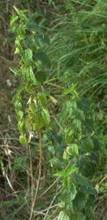 |
|
|
|
|
Harvesting |
|
Ramie is normally harvested two to three times per year but
under good growing conditions can be harvested up to six times
per year. Harvesting is done just before or soon after the onset
of flowering, since there is a decline in plant growth at this
stage and maximum fiber content is achieved. Stems are harvested
by cutting just above the lateral roots or the stem can be bent,
to enable the core to be broken and the cortex can be stripped
from the plant in situ. Mechanical harvesters have been
developed but are not used commercially. After harvesting, stems
are decorticated while the plants are fresh as the bark gets
harder to remove as the plant dries out. The bark ribbons are
dried as quickly as possible to prevent attack by bacteria or
fungi.
The
dry weight of harvested stem from both tropical and temperate
crops ranges from about 3.4 to 4.5 t/ha/year; a 4.5 ton crop
yields about 1,600 kg/ha/year of dry non-de-gummed fiber. The
weight loss during de-gumming can be up to 25% giving a yield of
de-gummed fiber of about 1,200 kg/ha/year.
|
|
|
|
Extraction of fiber |
|
Extraction of the fiber occurs in three stages.
|
|
● |
|
Firstly, the cortex or bark is removed, either by hand or
machine, in a process called de-cortication. |
|
● |
|
The second stage involves scraping the cortex to remove most
of the outer bark, the parenchyma in the bast layer and some
of the gums and pectins. |
|
● |
|
The third stage involves washing, drying and de-gumming of
the residual cortex material to extract the spinnable fiber.
Details of the de-gumming processes tend to be regarded as
commercial-in-confidence information |
|
|
|
|
Ramie fiber |
|
Ramie fiber is one of the premium vegetable fibers. The ultimate
fibers are exceptionally long and are claimed to be the longest
of vegetable origin, with one report claiming the fibers range
up to 580 mm, averaging about 125 mm.
Ramie fiber is very
durable, is pure white in colour and has a silky luster.
For
the hand spinner, ramie is treated similar to flax in that it
can be either wet or dry spun. A wet spun yarn will produce a
smooth softer yarn with high luster, while a dry spun yarn will
feel hairier, have less luster and a harsher handle. It can
readily be blended with other fibers such as wool or silk,
although the length of ramie can sometimes cause difficulties. |
|
 |
|
|
|
|
|
|
Ramie spinning technology
|
|
|
|
|
|
Background
information |
|
History
|
|
Ramie is one of the oldest textile fibers. It was used in mummy
cloths in Egypt during the period 5000-3000 BC and has been
grown in China for many centuries. Brazil
began production in the late 1930s with production peaking in
1971 with about 30,000 t. Since then, production has steadily
declined as a result of competition with alternative crops, such
as soybeans and the importation of synthetic fibers. Production
in the Philippines began in the early 1950s, peaking in the mid
1960s with 5,500 t. Since then, production has declined
steadily.
|
|
|
|
Our
supplier partner
|
|
Hunan Isunte
|
|
Ramie
(Boehmeria nivea (L.) Gaud, is the only member of the Urticaceae
family used commercially for fiber production. The plant
produces a large number of erect and slender stems or stalks,
usually non-branching and grows from 4 to 7 leaves that are
silvery white underneath, 7.5 to 15 cm. long with clusters of
small greenish flowers, ranging from 8 to 16 mm in diameter. The
stalks turn brown and woody as they mature.
The fiber obtained from Ramie plant is one of the strongest
vegetable fiber known in the world today. It possesses highest
strength and length, good durability and absorbency with
excellent luster. These remarkable characters make it rather
more suitable for use in the manufacture of wide variety of
textiles and cordage products. However, despite its unique
quality, ramie has received comparatively less prominence in the
calendar of important crops of the world.
Recently
with the availability of more technical know how, the crop has
started getting slightly more importance and the countries like
China, Brazil and the Philippines have come forward with
commercial cultivation. |
|
|
|
Principal
Uses |
|
● |
|
Fabric
- Ramie tetoron |
|
● |
|
Yams |
|
● |
|
Industrial Threads |
|
● |
|
Sacks |
|
● |
|
Carpets |
|
● |
|
Twine
and Cordage |
|
|
|
|
|
|
Conditions
Required for Growing
|
|
Ramie
grows well in the areas having good rainfall and warm climate.
The following type of soil and climate is best suited for ramie
cultivation.
|
|
|
|
Soil
|
|
The soils
best suited for ramie are sandy loam or loamy, very sandy. The
clayey or gravel soil is not suitable. The plant is too much
sensitive to soil moisture conditions. It grows well in land,
which have adequate supply of moisture, well distributed
throughout the growing season. Soil must be well-drained i.e.
high land and should have no problem of water logging or
flooding. Flat and slopy lands are good. Ramie plants give poor
growth in the dry sandy soil and the poorly drained soils. The
soils deficient in calcium and poor in Base Exchange capacity
are also not suitable unless proper liming is done and
sufficient organic manure is added. The pH of the soils for
ramie should be around 5.5 to 5.6.
|
|
|
|
Climate
|
|
Ramie is
grown best in a warm moist climate where the temperature during
winters goes down to freezing. A temperature of approximately
25°C to 31°C during the summer and rainy months with annual
rainfall of 1500 to 3000 mm. evenly distributed throughout the
year is considered good for the growth of the crop. However, the
crop makes very little growth during winters. It is usually
grown at altitudes less than 300m above sea level. The ramie
plants are very much sensitive to frost. Even strong winds are
harmful as during storms the stalks rub with each other
resulting in breaking and ultimate lodging of the canes. The
relative humidity of 80% during the growing period is found to
be best.
|
|
|
|
Methods of
Cultivation
|
|
Ramie is
propagated vegetatively through rhizomes for commercial
production throughout the world. The cuttings of rhizomes are
planted directly in the field and the plants arising from them
spread rapidly. Rhizomes are obtained from the roots of healthy
and disease free plants which are dug out by a spade from an
already established plantation. The rhizomes are then removed
separately and cut into pieces of 10 to 15cm. in length.
These
pieces are planted in field immediately or may be stored in a
shady place for a week or so before planting. The practice of
propagation through rhizomes ensures good sprouting, clonal
purity and is economical. It makes the cultural operations also
simple. The quantity of rhizomes obtained from an unit area
depends on the age of plantation and variety. Usually the
quantity of rhizomes obtained from one hectare of 2 years old
plantation can give enough planting material to cover at least
20 hectares of land.
As a
perennial crop, ramie occupies the land for a number of years.
It is, therefore, necessary that the land is deeply and
thoroughly prepared. Planting should invariably be done under
good soil moisture condition. The planting period may extend
from May to September depending of course on the local seasonal
conditions. Rhizomes are planted 45 c.m. apart within the row
and 60 c.m. between two rows. About 250 to 275 kg. of rhizomes
are required for covering one hectare of land in a spacing of 60
cm x 45 cm.
Ramie can
also be cultivated in open blocks or as intercrop with coconut
plantations as is normally followed in the Philippines. Good
results have been obtained when sufficient quantity of organic
manure is applied in the field at the time of land preparation.
Lime if needed should be applied at the time of land preparation
itself at least 3 to 4 weeks before planting. The land is
leveled after proper laddering.
|
|
|
|
Methods of
Production
|
|
● |
|
Rhizome cuttings - 80-95% germination |
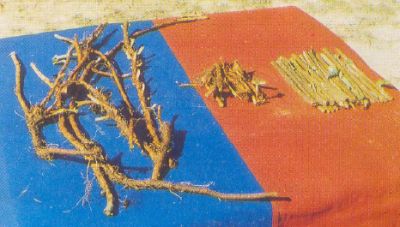 |
|
● |
|
Divisional of parent stock - 90% germination |
|
● |
|
Layering |
|
● |
|
Stem
cutting
|
|
|
|
|
|
|
|
|
|
|
|
|
|
|
Planting
Season
|
|
Ramie can
be planted at the start of the rainy season, or anytime in
places where rainfall is evenly distributed throughout the year.
|
|
|
|
Distance
of Planting
|
|
Cuttings
are usually planted in furrows spaced 40 to 50 cm apart and 3 cm
deep at an angle of 45° leaving 1/3 or the length of the cutting
above the ground and 2/3 covered with pulverized soil. If
rhizome cuttings are used, they should be set in furrows about
3-4 cm deep, laid either flat or at an angle of 45°, from 30-40
cm apart in rows 80-100 cm between rows.
|
|
|
|
Rate of
Fertilization
|
|
If the
soil is rich, additional fertilizer of 80 kg N, 60 kg P2O and 60
kg K2O is recommended. If the soil is deficient such as sandy
loam soil, higher rates of nitrogen and potassium are needed.
Apply fertilizer using split method of application, spread out
from 5 to 8 times annually.
|
|
|
|
Some Major
Pests and Their Control
|
|
● |
|
Leaf
roller - causes heavy infestation resulting in complete
defoliation and cessation of the plant growth. |
|
● |
|
Ramie
weevil - brown beetle and green looper feed directly on
buds, leaves and petioles. Spray with Methyl Parathion. |
| |
|
Black
caterpillar - feeds directly on leaves thus leaving the
veins with a mesh-like appearance before falling. This can
be kept under control by spraying with organophosphorous
insecticides. |
| |
|
|
|
|
Some Major
Nematodes and Their Control
|
|
● |
|
Cotton-root-knot
nematode
- causes
root
galls.
Control
with
available
nematicides. |
| |
|
Bud
nomatodes, pin nomatodes - result to blighted tips of ramie
plants. Use available nematicides. |
|
|
|
|
Maturity
and Harvesting
|
|
Seventy
days after planting for the first harvest and ratooned 45-60
days for the succeeding harvests. Maximum of fiber yields are
attained on the second and third year. Rejuvenation of the area
is needed after 4-6 years.
|
|
|
|
Method of
Extraction
|
|
● |
|
Retting - extraction of fiber by means of soaking the stalks
in running water, pond, lake of designed tank. |
|
● |
|
Raspador-decorticator - a twoman raspador-decorticator could
produce 100 kgs of dried ramie fiber a day. |
|
|
|
|
Yield per
Hectare
|
|
Ramie has
an average yield of 1,575 kg of dry fiber based on three
cuttings per hectare per year. Approximate potential yield of
ramie per hectare (per year) may reach 2,700 to 4,800 kg of
fiber per year. Dry fiber recovery ranges from 3.5% to 5%.
|
|
|
|
Official
Standard Grades
|
|
Decorticated
|
|
● |
|
RD-A -
Special |
|
● |
|
RD-1 -
Good |
|
● |
|
RD-2 -
Fair |
|
● |
|
RD-3 -
Short |
|
● |
|
RD-O -
String |
|
● |
|
RD-T -
Tow |
|
● |
|
RD-W -
Waste |
|
|
|
|
Fermented
|
|
● |
|
RF-A -
Special |
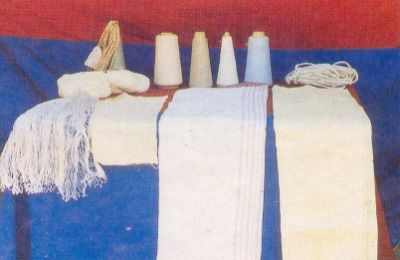 |
|
● |
|
RD-1 -
Good |
|
● |
|
RD-2 -
Fair |
|
● |
|
RD-3 -
Short |
|
● |
|
RD-W -
Waste |
|
|
|
|
|
|
|
|
|
|
|
|
|